Hunt: Showdown and Encouraging Design
By lapsariangiraff 23 Comments
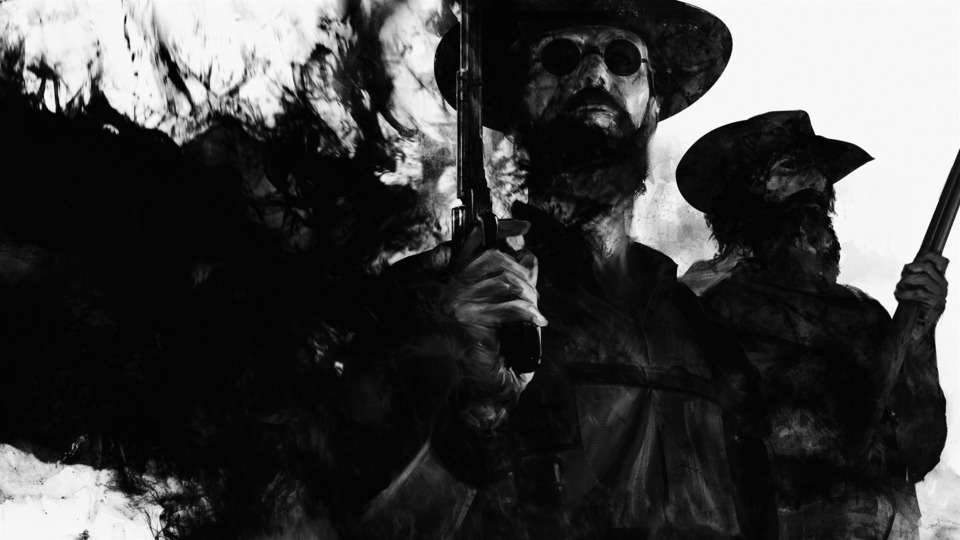
“Given the opportunity, players will optimize the fun out of a game.” –Soren Johnson
A while ago, I posted a lengthy diatribe against Cyberpunk 2077. I had plenty of issues with it: the story didn’t resonate with me, the gameplay wore out its welcome before I had finished all of its quests, and I left feeling that the experience was empty—not just in the lack of thematic follow-through, but in the lack of meaningful interactions in Night City itself. One point that came out of the resulting discussion in the comments was that Cyberpunk is potentially more enjoyable if you play mostly the critical path, and don’t go out of your way to find all the side-quests in the world. However, the game encourages you, nay, pushes you to engage with this additional content, through the pushy text messages, through the “wait for this person to call” gaps in the main storyline giving you space to explore the world. Yet, once you do, you find some of the weakest content in the game.
So, this raised a fundamental question about game design—is there such a thing as playing a game wrong? And how much of that onus is on the player, or the developer?
To answer that question, let’s talk real quick about XCOM.
The Achilles Heel of Modern XCOM
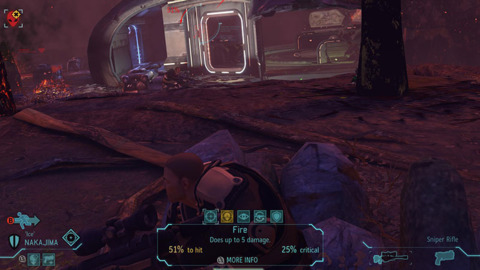
Make no mistake: the 2012 XCOM: Enemy Unknown is a fantastic game. At the time, it felt like a minor miracle for XCOM fans, especially in the wake of The Bureau, a misguided attempt to turn the XCOM universe into a third person squad-based shooter.
And! As someone who tried to get into the original game, but bounced off due to the overwhelming number of options and punishing difficulty, XCOM 2012 was perfect for me. Even just the UI and moment-to-moment combat was so streamlined, while retaining the essential difficulty and drama of the original. It was far less punishing—but it felt like XCOM any time you accidentally activated a pod of 4 Mutons or missed a 93% shot. This is not to mention the incredible meta-layer either, which smartly presents one new mechanic or consideration at a time, until eventually you’re juggling power, satellite capacity, research and upgrades, terror levels, and of course, money. In the best way, there was always a clear next step or thing you needed, and this combination of carrots and sticks made it very easy to just—keep—playing for hours on end. (For me, both the original and the expansion on PC and iPad.)
There was, however, a big issue, one that made itself more evident as a run would veer into the late game. This is far from an original observation, but as the player’s squad members got stronger and stronger, and the only way enemies could meet this upgraded firepower was with comically oversized health bars, XCOM got less interesting as it progressed. A Berserker is a melee only Muton with a big health bar. A Sectopod is a Chryssalid that does more damage and has more health. An Ethereal is a juiced up Sectoid that—again—has more health.
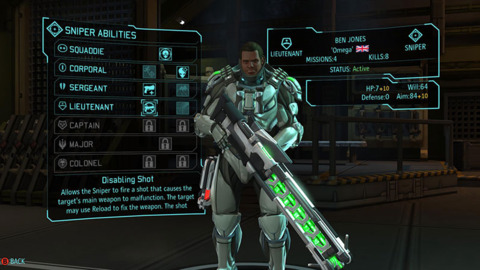
On top of that, while levelling up individual soldiers created stronger attachments to those soldiers (and therefore more drama when they died,) it did also encourage a lot of players to hold on to their first six soldiers for dear life. They wouldn’t bring new recruits because, hey, you want to bring the best soldiers for the best chances of winning. Then, having only 6 sets of high-powered equipment is cheaper than keeping replacements on hand, which gives you more money for upgrades. BUT. Once you’ve committed to this playstyle, if more than one of your original soldiers dies, it’s almost crippling. On non Iron Man playthroughs, this encourages save-scumming (the practice of saving on every round and retrying it to get the perfect outcome).
Of course, this is a problem for new players, mostly. More experienced players (or Iron Man players) will know to take the financial hit and have a large pool of soldiers and equipment. Yet even the most skilled players (I think of watching a streamer called Tornis play Impossible Iron Man runs) run into issues of passivity. The best thing to do, without question, is to Overwatch five members of your squad and send one forward as a scout. Even better if you only activate one pod of enemies at a time. On the late-game longer alien ship levels, this is a curse, as you inch forward one movement distance (without dashing, mind you) at a time. This is an honestly boring way to play once your crew is levelled up; victory in combat is a tedious inevitability, rather than a precarious uncertainty.
So, XCOM is a great game, but it had this glaring flaw, and its designers noticed. So, when XCOM 2 was released in 2016, a change was implemented to encourage a different playstyle.
And people hated it.
Punishing vs. Encouraging Design
Note: I’m borrowing a fair bit of this section from the Game Maker’s Toolkit.
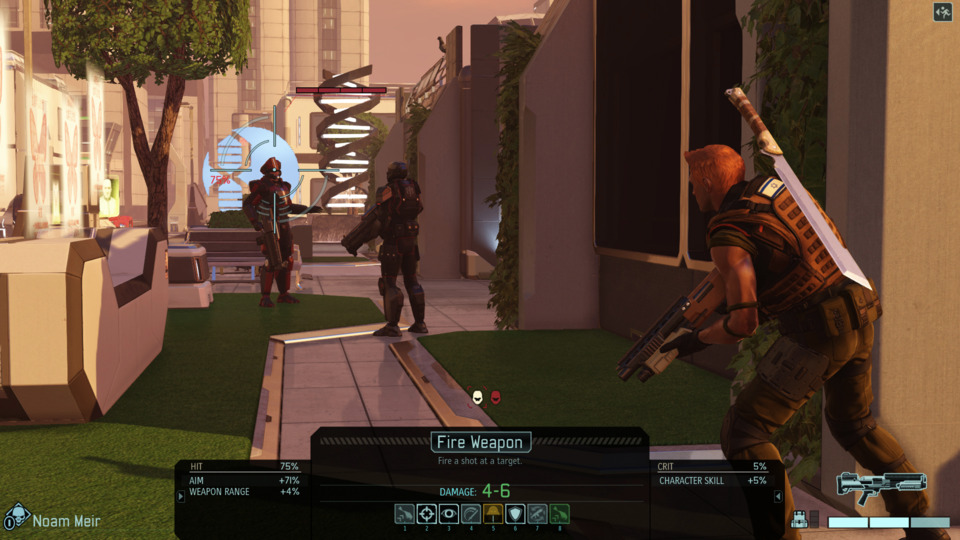
In base XCOM 2, almost every mission has some kind of ticking clock. “Extract in 12 turns or everyone is captured!” “Destroy this object in 7 turns or the mission is lost!” “Enemy reinforcements will arrive in 2 turns!” It makes sense thematically, at least, as XCOM is now a resistance force on an Alien-occupied Earth. Personally, I really dug this. Like many players, I will chronically choose the least fun option or playstyle if it is the most efficient or materially rewarding in a game, and this change in XCOM 2 helped protect me from myself. Honestly, I loved the base game so much more than the original. I was taking risks and making insane plays that made for great stories, when before, I would just play as safely as possible. Even failing under this new system was fun, as one of my best snipers, the Papa Bear figure of the squad, stayed back to hold off the aliens as the rest of my squad evacuated. Many in-game hours later, I rescued him from a prison, but he had to readjust to an XCOM that had been forced to move on from him.
I’m apparently in the minority though, as most players hated the new time pressure. For players who enjoyed a safer playstyle, the timers felt like an unnecessary punishment for what they found fun. Jake Solomon in an interview mentioned that this change was implemented because, in his view, the best way to play XCOM is when you’re taking risks, and the timer was a brute force way to achieve this goal. But while it works to change the best way to play, unquestionably, it didn’t feel great for a lot of people. And “feel” is one of the most important aspects of game design.
Game Maker’s Toolkit brings up how the designers could have rewarded fast play, rather than punish slower play. What if you got extra resources for getting out of the mission quickly? What about a system similar to Enemy Within’s Meld caches that shut down after a couple of turns on the map? I haven’t played War of the Chosen yet, but I hear lots of good things about the changes they made.
Given a choice, I think most people would prefer being rewarded in a game instead of being punished. And Hunt: Showdown, Crytek’s cowboy battle royale-like, does this very, very well.
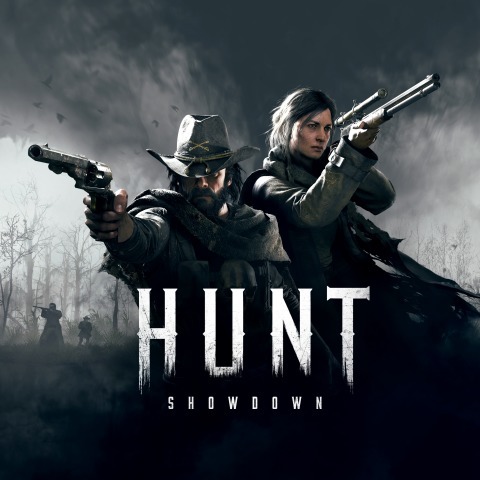
The Mechanics of One Round in Hunt: Showdown
Since this February, I’ve been playing Hunt: Showdown near nonstop, at least a few times a week with a group of friends, and 100 hours in, I’m pretty sure this is a near-perfect game.
Hunt: Showdown is a 12 player PvPvE battle royale set in an alternate historical Louisiana, 1895, in which zombies and all kinds of other monsters have overrun the bayou. You (and up to 2 squad members) have to kill a monster on the map, and extract from the map with your bounty while other hunters vie to do the same. This is a neat concept, and just from screenshots you can see that the aesthetic of this game is dripping with style, but where Hunt excels most is in how the ruleset encourages players to play in the most exciting way, every round.
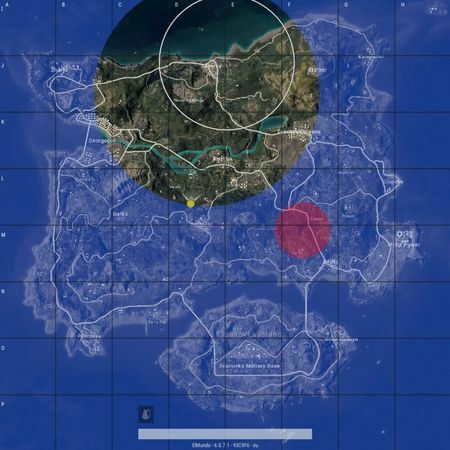
From the beginning, you’ll notice that Hunt lacks the usual “circle of death” that defines most battle royale games. Now, why that circle of death is there in say, PUBG, makes perfect sense. On such large maps with so many players, it’s necessary to funnel them all into the same space to force conflict. Much like XCOM 2’s turn timer, this works in a brute force way. People get smooshed together on the map, and players who refuse to stick to the game’s timing for too long will die as the circle damages them. However, there are a few unavoidable kinks in the system.
First, there is an element of randomness to the circle. Depending on where you dropped on the map and where the first or second circle spawns, you may spend a long time just running, searching for a vehicle, or driving. Or on the other hand, you may find yourself at the center of the circle, and just sit there for a few minutes. This is mitigated as there’s less space to cover, but it can severely impact a round. Second, the timer, combined with the loot drops, make success in the game mostly an arms race—whoever can get the best equipment before the final circles, either from looting houses or defeating other squads. Thirdly, if the Sacriel streams I watched were any indication, the circle of death could be circumvented with enough health items, so skilled players could get a long free looting period in the best areas of the map, simply by staying outside the radius longer.
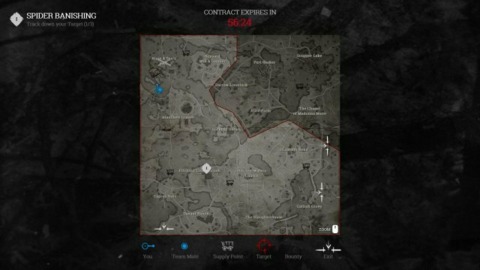
Hunt accomplishes the same consolidation of players with a different system—the clues and bounties. Since the primary goal of the game is not to be the last player standing, but simply to extract a bounty, players naturally congregate into the same areas without the need for such a strict boundary as “a circle that kills you if you’re not in it.” To find the boss, each squad has to find 3 clues (less if they accidentally stumble on the boss lair earlier), and each clue highlights a smaller area on the map to explore. Now, there’s still some randomness—I’ve definitely had games where my team spawns right next to a boss to begin with—but for reasons I’ll explain later, it doesn’t affect the enjoyment of each match nearly as much. Players also bring in their own loadouts, rather than starting unequipped and having to scrounge for items, so the experience is completely focused on “get the bounties and get out,” rather than the competing priorities of “kill guys, get into the circle, find new gear” of most battle royales.
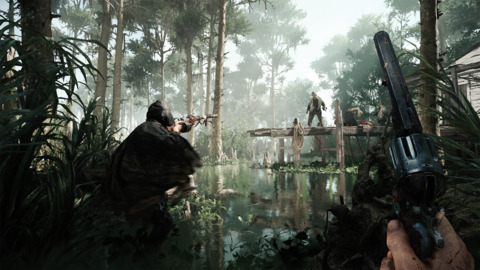
Of course, as the area you need to search shrinks, your likelihood of running into another squad increases, and Hunt goes to greater lengths than its battle royale peers to make this presence known. Sound plays a crucial role throughout the entire map, to the extent that parts of Hunt play like a light stealth game. It takes one of my favorite parts of PUBG—tracking other players—and creates more concrete ways to do so. There are ambient zombies and monsters lingering around compounds on the map, all of which will unavoidably make some noise as you draw their aggro and kill them, but you learn quickly there are louder and quieter ways to deal with NPCs. A gun shot is obviously the loudest way to deal with a zombie, but a knife, while the zombie will growl at you, takes them out much more discreetly. A silenced pistol or throwing knife before a zombie even notices you, though? You’re golden. But it’s not just monsters or gunshots that can give your presence away—the map itself is littered with sound hazards. Murders of crows sit on fences and wires, just waiting to fly up into the air cawing if you sprint too close to them, water fowl can be scared in a similar way. Then, within compounds themselves, there are micro cues that don’t reveal your position from 100 meters away, but can be fatal when two squads are occupying the same area—bits of broken glass on the ground, chains hanging from the ceiling that clink as you walk through them, empty cans that rattle as you walk over them. Different materials also create different levels of noise, so if you’re walking through water or on a metallic roof, you’ll make a lot more noise than crouching on dirt.
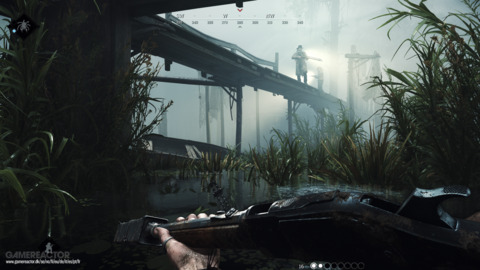
Thanks to bounties, not player kills, being the objective, when you hear another squad nearby, it’s a much freer choice between sneaking away from those players or choosing to fight them. If you fight, you’ll find that Hunt is a tense, methodically paced shooter that rewards positioning more than split-second aiming (though it can come down to that, of course). Especially early on, weapons are slow-firing revolvers, repeaters, and bolt action rifles with high damage that reward landing your shots, but give players ample time to retreat and heal themselves if their opponent isn’t aggressive. The range of these older weapons also tends to create mostly mid-range engagements, as at close range, guns are less a guaranteed kill and more an opportunity for the enemy to pull out a knife and stab you (melee weapons are very effective in this game). Guns aside, Hunt is up there with CounterStrike for the utility of its tools and grenades. A swarm of bugs in a jar that chases and poisons the nearest player, Molotov cocktails, choke bombs that can put out fires and prevent the fuse on sticks of dynamite from being lit, trip mines that spring up barbed wire when activated—entire fights can be decided with smart item usage. In team fights, players can be revived multiple times, but an incapacitated player that has been set on fire will eventually be dead for good. With this combination of weapons, tools, and the increased emphasis on sounds during teamfights, every engagement is tense and rewarding.
This changes a bit as later weapons are unlocked, more modern-feeling arms such as semi-automatic shotguns, scoped rifles like the Mosin-Nagant that increase the range of an engagement substantially, or semi-automatic pistols like the Bornheim or Dolch, which take a lot of the tension out of gunfights and make “spraying and praying” a legitimate option. But, aside from that power creep, Hunt does an admirable job of making every weapon a viable option, and having very few, if any, straight-up bad options to bring into a firefight.
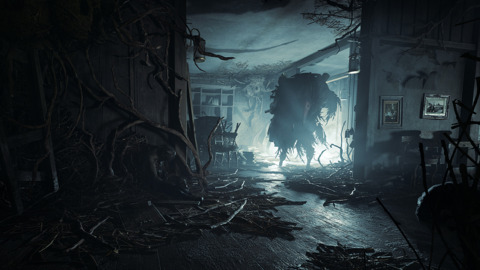
Wisely, the bosses themselves are not difficult to kill, as they have a reasonable amount of health and simple attack patterns. The spider will crawl around on the walls and ceiling and leap to attack. The Butcher, a large monster wearing a pig head and butcher’s smock while waving a flaming hook, will chase and swipe at the players in a straight line, but Choke Bombs can put out the hook so he doesn’t set the player on fire. The Assassin darts around as a swarm of bugs before reforming as a solid foe to melee attack or ranged attack players. And the newest addition, Scrapbeak, is a scavenging crow monster that will throw down barbed wire to limit player movement while trying to melee attack the player.
Once the boss has been defeated, there’s a prolonged “banishing” period of a few minutes where the entire map can see that a boss has been defeated, where it is, and that you’re attempting to harvest its bounty. This naturally creates a “King of the Hill”-esque moment in the round, as the Banishing squad starts placing trip mines and bear traps at entrances to the compound (or maybe you want to ambush approaching squads from an unexpected angle further up?), and attacking squads attempt to siege the building. These fights are intense, as the defending squad has every motivation to stay in the same area, no matter how hard the fighting gets, and the attacking squad is motivated to defeat the defenders before they are done banishing the boss, because whoever picks up the bounty gets Dark Sight.
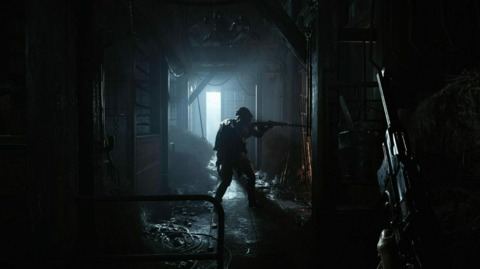
Dark Sight, before banishing the boss, is essentially a detective vision that lets you see where clues are in the distance with a blue glow. But once you pick up a boss’ bounty, Dark Sight lets you also see where other players are for 5 seconds. Whoever has it possesses a large advantage in team fights, motivating players to kill a squad before they get their hands on, basically, sanctioned wall hacks. But once a bounty is picked up, the bearer has not only wall hacks, but a permanent mark on the map for every squad to see their general location.
Now, whether or not the squad with the bounty has won a fight, they have to get to one of three extraction points on the map and hold it for 30 uncontested seconds to leave. This gives other squads one last chance to catch them, as they can see where they’re headed by the bounty marker on the map. Having been on both the giving and receiving end of fights at extraction points, there are few things as thrilling as keeping your head down as bullets whiz by and the timer counts down, or downing a member of an enemy squad just as they’re about to escape. Truly devilish minds (my friend group has only pulled it off once) can place mines at the extraction and lay out an ambush ahead of time for an extracting squad.
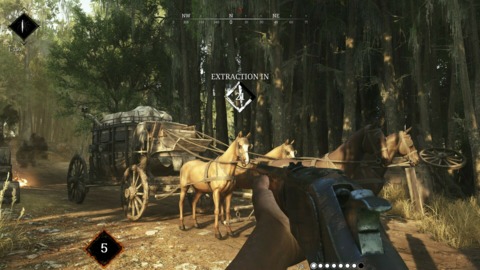
Sometimes, there are two bosses, and therefore two bounties on a map. This spreads the fighting out a bit, and can lead to some ho-hum rounds if every other squad decides to fight over a different bounty than the one you picked up, but that’s a rarity at higher levels, as people are much less “immersed” in just surviving, and more prone to get into fights. The one bounty maps can get hectic quickly, as I’ve had fights with four squads at once in one compound—and this is where positioning and maneuvering come to the forefront, as moving smartly can be the difference between squads fighting each other and two squads ganging up on you.
It’s understandable why some players want to play safely though—as harsh as the combat and stealth in Hunt are, it’s even harsher when you account for the fact that the game has permadeath.
Well, sort of.
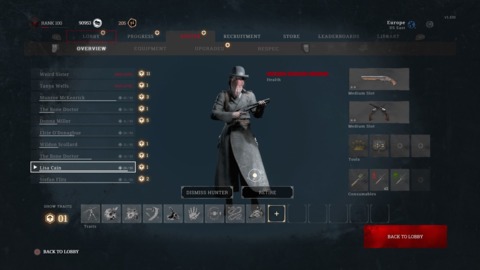
Individual characters and loadouts in Hunt are plentiful, yet disposable. If you die, your character, with all their perks and equipment, is gone forever. But, recruiting more hunters is cheap and infinite, as you can, even if you’re flat broke on in-game currency, recruit one free hunter for every round. The real expenses come in the form of later game weapons and items, which cost a lot more, creating more of a CounterStrike-esque economy (as Super Bunnyhop mentions) than an actual rogue-like permadeath. Once an item is unlocked, it can be purchased as many times as you can afford it. That being said, if there’s a fault I can take with the game, it’s the later game weapons and the implication of the menus that your character’s life is far more valuable than it actually is. It doesn’t help that the menus are pretty clunky to buy new equipment—you can’t save and buy your favorite loadouts at the press of a button, the best you can do is favorite anything you actually want to buy and scroll through that list instead. It just means that there’s an extra minute between rounds that’s unnecessary.
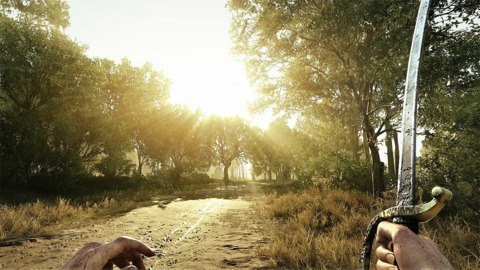
Otherwise, though, I have no complaints with this game. It’s gorgeous, its aesthetic and world serve the gameplay and design, and it’s just a masterclass of objective design in multiplayer games in general. Maybe I’ve rambled too much, but in short: the design fluidly encourages players to come into conflict with each other, ambush each other, have tense standoffs with each other, in a way that no other battle royale does quite as effectively. Plus, it does all of this while keeping the player firmly in the driver’s seat and making them feel like they are being proactive in charge. The clues are a natural reward and motivation, the bosses and bounties are natural motivations, and the best rewards the player can get come from playing in a fun way, rather than punishing the player for not sticking to the pace the game demands. I haven’t even gotten to some of the more interesting monster types throughout the world, or how consistently the rules of items, monsters, and players interact with each other in an almost Breath of the Wild way.
If you like tactical shooters, multiplayer shooters, or are even mildly interested in what I’ve described here, I highly recommend checking out Hunt: Showdown. It’s really damn good.
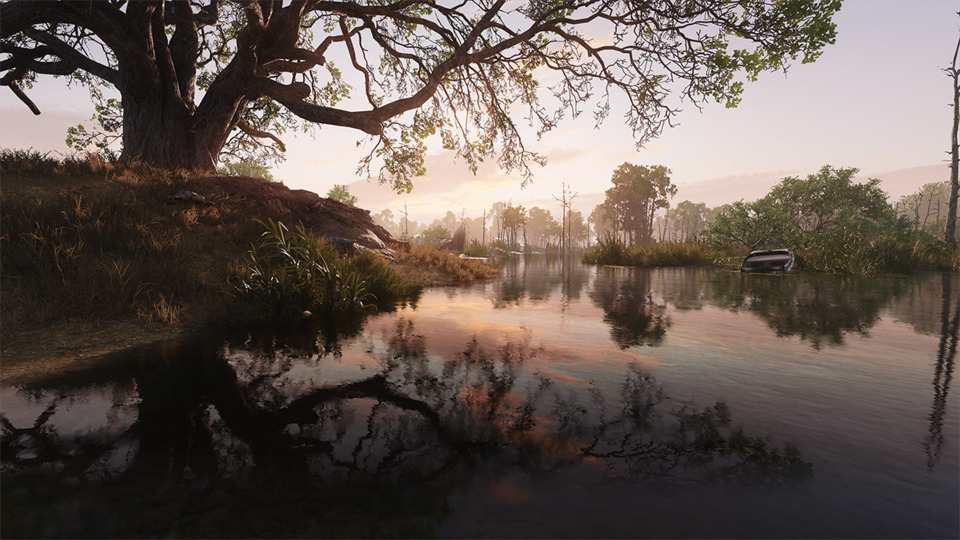
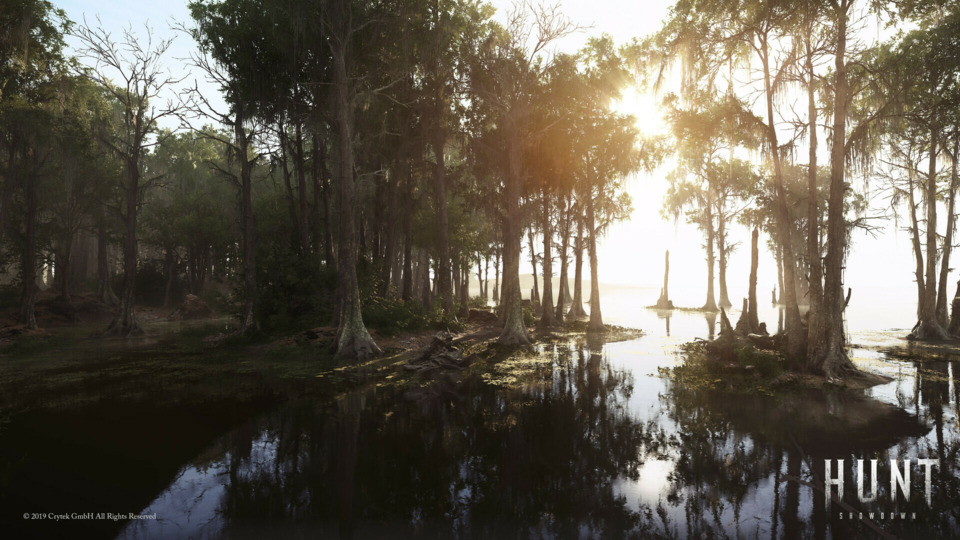
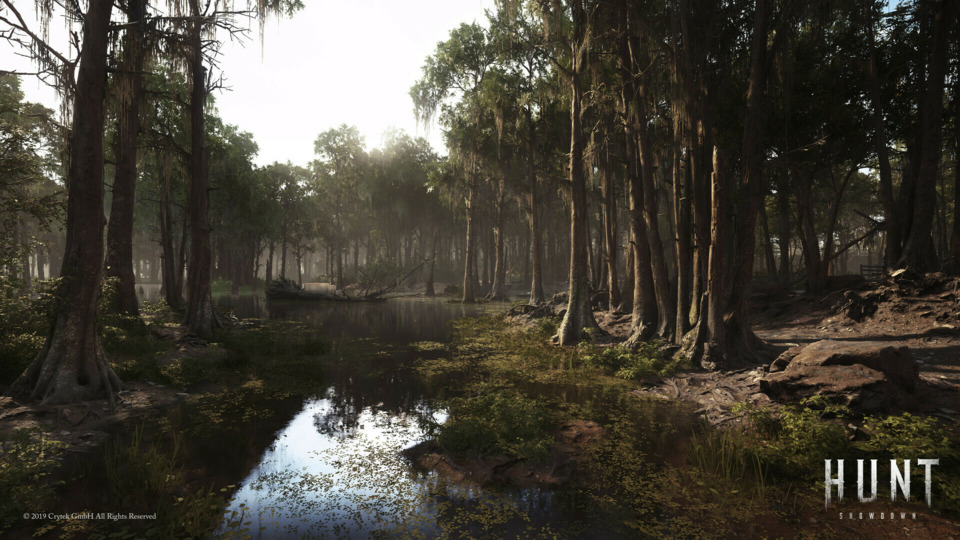
And did I mention gorgeous?
